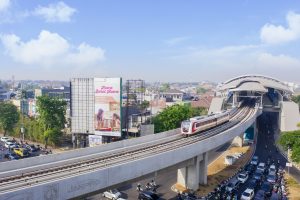In recent years, Indonesia’s public transit infrastructure has received a significant makeover. The long-awaited high-speed rail (HSR) connecting Jakarta with Bandung is undergoing public test runs now and will start commercial operation at the beginning of October. Last month, the Greater Jakarta light rail system (LRT) went into service. The first leg of the Jakarta Mass Rapid Transit (MRT) has been open for a few years now, and is currently being extended up to the historic Kota Tua area.
These efforts have not been without controversy. Costs, planning, design, land acquisition, environmental impacts, use of foreign debt, and the role of domestic firms and industry have all been hotly debated. As these high-profile projects reach completion, now seems like a good time to look back and take stock of Indonesia’s alphabet soup of public transit systems.
Investing in transportation has several goals. The most obvious one is to move goods and people around more efficiently. In theory, this improves the competitiveness of firms, reduces emissions and traffic, and generally boosts economic activity. A second goal is the acquisition of new technologies and know-how.
This goal is particularly important for emerging markets like Indonesia, because it creates foundations for long-term growth. Transportation systems are technology and skill-intensive. They involve skilled labor, mastery of technologies like signaling systems, and a certain level of competence in industrial and construction techniques.
Indonesia doesn’t just want foreign firms to come in and build transportation systems. During the planning, construction, and operation of these systems Indonesian firms want to acquire new operational and production capabilities from foreign development partners. The goal is for Indonesian companies to eventually be capable of doing all, or at least major parts, of these complex transit projects themselves.
The Jakarta MRT is a Japan-backed project. It is owned and operated by the Jakarta municipal government, and financed by concessional loans from Japanese development banks at very low rates of interest. Japanese engineering and construction companies have featured heavily in the planning, design, and building of the MRT system. Several state-owned Indonesian companies, such as Adhi Karya, are participating in the construction process as minority partners in joint ventures with Japanese firms. Many of the more complex components, like rail management systems and rolling stock, have been handled primarily by Japanese construction and engineering firms.
The Jakarta-Bandung HSR is, as everyone probably knows by now, being developed in tandem with China. At a cost of over $7 billion, it’s financed by non-concessional loans from Chinese banks, which means the interest is closer to the market rate. Another difference is that the HSR is structured as a joint venture in which Indonesian companies are the majority partner, with a 60 percent stake.
The idea is that such a structure will facilitate more transfers of technology and know-how between Chinese and Indonesian firms. This project has attracted a lot of attention because of the high cost, the questionable planning choices, and the delays and environmental issues. But if it results in the acquisition of new skills and capabilities by Indonesian SOEs, than the trade-offs might be worth it. Of course, that’s a big if.
The Greater Jakarta LRT is a home-grown project being run by state-owned companies. Adhi Karya has been doing most of the construction. INKA, the state-owned rolling stock company, manufactured the train carriages. PT Len has been working on the signaling system, and railway company KAI will operate it. Siemens has been working on software, but by and large this is a made-by-Indonesia LRT.
It has also been plagued by delays and issues. During test runs in 2021 a pair of trains collided. When the line finally opened for service in August, there were many operational problems including reports of rough braking, delays, and long lines. The design and construction have been criticized, as train cars have to go very slowly at one section.
But look at the trajectory over the last decade or so: from a Japanese-financed MRT in which Indonesian construction companies participated as junior partners, to an HSR where Indonesian companies are the majority shareholder, to an LRT where Indonesian SOEs have taken the lead in designing, building, and operating a complex system in a challenging urban environment. What these firms are trying to do is acquire and develop indigenous capabilities, and the long-term success of these endeavors should really be judged by whether and how well that happens.
The issues with the LRT are not that surprising given limited experience with such complex systems. The more important question, in my mind anyway, is whether firms like INKA, Len, and Adhi Karya are learning from it. Are the techniques, skills, and knowledge acquired during the process of constructing and operating these systems going to result in iterative improvements over time? We will have to wait and see. But given that there is no shortage of demand for more public transit systems in Indonesia, I don’t think we will have to wait long to find out.

































